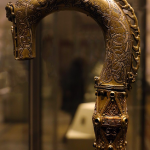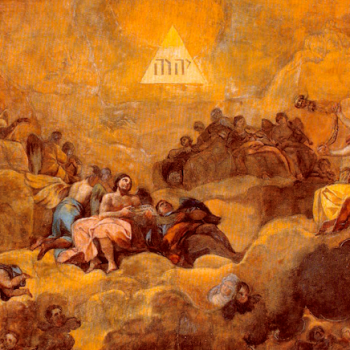God the Vintner
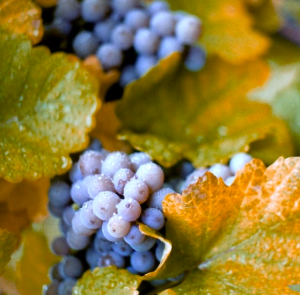
North American grapes (vitis labrusca)
of the Concord variety.
Vineyards and wine are common motifs in Scripture. This is natural; along with wheat and olives, grapes are one of the most important crops throughout the Mediterranean. Wine was extremely important in antiquity, and drunk from pretty young ages by our standards, because of something we virtually never reckon with: the difficulty of finding clean water and keeping it clean. Unless you lived by a mountain spring—which, no you didn’t, because living up a mountain would be an absolute pain in the neck for every other purpose but getting that nice fresh spring water—your water was most likely coming from a river. As in, a river full of animals. And not just the kind of animals you can see. So yeah, we’re mixing some wine into that water! Kill the pathogens and make the wine last longer, win-win. (I don’t know about Hebrew, but in Latin, the presumption that any vinum, any wine, you were offered would be mixed with water was strong enough that they actually used a distinct word, merum, for unmixed wine.)
There are many references, in the Old Testament as well as the New, to Israel as God’s vineyard or God’s field. Isaiah 5 is a classic example; there are multiple parables about vineyards and their workers, fields and their farmers, fig trees and their … fig tree guys. (“Ficicists,” maybe?) This links up with two other Scriptural motifs, motifs we don’t habitually associate either with vineyards or each other; however, I’m inclined to think St. John had them very much in mind when he wrote this Gospel.
One is the image of the wrath of God represented as a cup, or occasionally a bowl (drinking bowls, though borderline unheard-of today, were standard vessels in antiquity). This appears in the Psalms (e.g. Psalm 75), and it’s all over the Prophets: Isaiah, Jeremiah, Obadiah, it’s everywhere. The same symbol makes it into the New Testament: on at least two occasions, Jesus describes his Passion as a “cup” from the Lord, while in Revelation 15-16, the “golden bowls” or “vials” that contain the “seven last plagues” were a type of drinking bowl, used to pour libations.
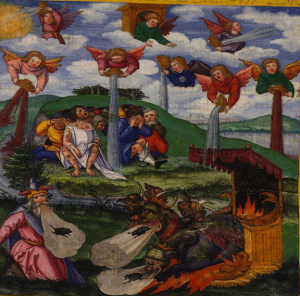
Seven angels with the seven last plagues, full
of the wrath of God who liveth for ever and
ever, though they honestly seem pretty chill
about it (by one Matthias Gerung, c. 1531).
I’m not clear why a bowl or cup of strong wine was a symbol of judgment; my guess would be that it had something to do with drunk people making fools of themselves. In any case, there the image is.
Ready for some poetic whiplash? No? Too bad, it’s the Gospels, that’s practically guaranteed. The other image is …
The Bridal Feast
The vineyard, and fields generally, could be a romantic or erotic image as well. Using food, fruit particularly, as a metaphor for sexiness is one of the oldest tricks in the book, and it’s a pretty old trick in the Good Book, too. The book of Ruth seems to be alluding to it at the very least1; Psalm 45 has it in spades; the book of Esther opens with Xerxes and his pals getting sloshed at a banquet, after which the important movements of the plot continue mostly to take place over dinner, and Purim is celebrated to this day by getting sloshed (besides which Esther’s own Hebrew name, Hadassah, means “myrtle,” a plant whose berries were used both to produce a liqueur and as a pepper substitute). Supremely, you can barely get through a line of the Song of Solomon without your nose getting perfumed and delicacied right off your face from all the spikenard, cedar, myrrh, apples, figs, lilies, frankincense, pomegranates, honeycomb, saffron, cinnamon, aloes—and above all, over and over and over, the grapevines curl around every page, heavy with fruit; the very body of the bride, the Sh’lomith to Sh’lomoh,2 is described as a vineyard. This makes a lot of sense for, well, reasons that might come off a little misogynistic, with the … focus on fertility that marriage had in classical antiquity, and the metaphors invited by … well, ah, hm.
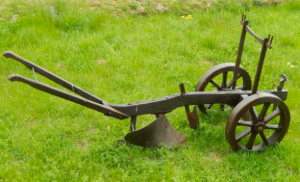
Oi. Get your mind out of the furrow.
But if you think going from God’s wrath to the Songliest writings of Solomon was all the whiplash we had in store, oh no. Already in the ancient world, the Song of Solomon was being interpreted by rabbis as an allegory of God’s love for Israel, which is also how the early Church read it—not because of any childish belief that “sex is naughty” (give the Irish credit, we came up with that one), but because all things were held in some fashion to have reference to their Creator. And this was not by contrivance, but because being, if it all came from one Source, could only be by reflecting its Source in some way.
Here, another step. Jesus reapplies the image. He does not avoid the motif of wrath; indeed, he actively courts it in verse 6. But he also makes himself this vine that his disciples must be united with, bodily, metaphysically. The language puts me very much in mind of one of C. S. Lewis’s finest passages:
“We are hearing much Greek wisdom this morning, King,” said the Priest. “And I have heard most of it before. … It is very subtle. But it brings no rain and grows no corn; sacrifice does both. … Much less does it give them understanding of holy things. They demand to see such things clearly, as if the gods were no more than letters written in a book. I, King, have dealt with the gods for three generations of men, and I know that they dazzle our eyes and flow in and out of one another like eddies on a river, and nothing that is said clearly can be said truly about them. Holy places are dark places. … Holy wisdom is not clear and thin like water, but thick and dark like blood.”
—Till We Have Faces, I.5
This may not feel at first like it belongs beside the Gospel of John, which is all about light. But remember, John’s imagery is extremely vivid and deliberate: three times, he tells us that the “scene” changes to nighttime. The first is when Nicodemus comes to Christ in secret. The second is when he walks on water to the disciples after feeding the five thousand. It can be easy to get lost in the back half of John, since most of chapter 13 and all of 14 to 17 inclusive is him addressing the Apostles; but one of the few interruptions in this flow is when Judas is sent out, with the baffling instruction “Do what you are doing quickly”; and then:
So, taking this morsel, he went out right away; and it was night.
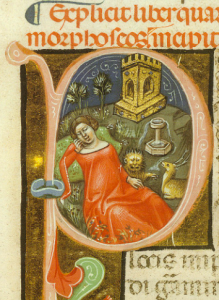
Psyche asleep in Cupid’s garden, from a 1345
manuscript (probably Milanese) of Apuleius’
Metamorphoses, the main source of the
myth of Cupid and Psyche.
John 15.1-8, RSV-CE
I am the true vine, and my Father is the vinedresser.a Every branch of mine that bears no fruit, he takes away, and every branch that does bear fruit he prunes,b that it may bear more fruit. You are already made clean by the word which I have spoken to you. Abidec in me, and I in you. As the branch cannot bear fruit by itself, unless it abides in the vine, neither can you, unless you abide in me. I am the vine, you are the branches. He who abides in me, and I in him, he it is that bears much fruit, for apart from me you can do nothing.d If a man does not abide in me, he is cast forth as a branch and withers; and the branches are gathered, thrown into the fire and burned.e If you abide in me, and my words abide in you, ask whatever you will, and it shall be donef for you. By this my Father is glorified, that you bear much fruit, and so prove to beg my disciples.
John 15. 1-8, my translation
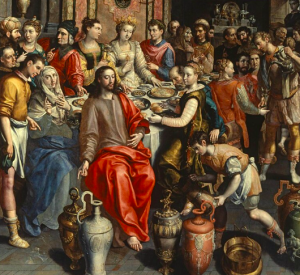
The Marriage at Cana by Maerten de Vos (1597),
located in the Cathedral of Our
Lady in Antwerp, Belgium.
I am the true vine, and my Father is the farmera: every branch in me that does not bear fruit, he takes it away, and every one that bears fruit, he cleansb it so that it may bear more fruit. Already you are clean, because of the word which I spoke to you; stayc in me, and I in you. Just as a branch cannot bear fruit by itself, if it does not stay on the vine, so none of you can, if you do not stay in me. I am the vine, you the branches. He who stays in me and I in him, this one bears much fruit, because apart from me you are not able to do nothing.d If anyone does not stay in me, he is thrown out as a branch and dried up, and they gather these and throw them in the fire, and they burn.e If you stay in me and my words stay in you, whatever you want, ask, and it will happenf for you; in this my Father is glorified, that you bear much fruit and becomeg my students.
Textual Notes
a. vinedresser/farmer: The distinction is admittedly small, but the Greek text uses the general word, not the specific one.
b. prunes/cleans: I don’t know whether viticulturalists3 ever refer to pruning as “cleaning”; the (minimal) research I did before publishing this suggested that when modern vitties4 talk about cleaning vines, they’re talking about eliminating any microbes—viruses, bacteria, fungi—that the vine might be infected with. I raise the question because the word used in Greek for “to prune” literally means “to clean, purify,” namely the verb καθαίρω [kathairō]. (Strikingly, the verb which both the RSV and I translate as takes away here is αἴρω [airō]; although the two words are not truly related, there is certainly a pun here: “do not bear fruit: αἴρω; bear fruit: καθαίρω.”) It’s related to other words that have also made it into English, like catharsis for “purgation” (from κάθαρσις [katharsis]—we went pretty direct with that borrowing). By some accounts, the many varieties of the name Catherine have the same origin.5
Anyway! Even today, it seems, one of the principal reasons to prune a plant is as a way to deal with infected branches; in a world with no pesticides, it would have been about the only way. Pruning can also promote growth, either in the long term and indirectly (by eliminating limbs that will unbalance a plant, for example), or directly and in the short term (plants have something like an immune response, and if pruned judiciously, they will not only heal the wound caused by the cut but spur more growth elsewhere in compensation for what has been lost).

A modern sickle, one of a few different tools
that can be used in pruning. (Sickles have
been unearthed in the Near East that are as
much as twenty thousand years old.)
c. Abide/stay: “Stay” struck me as a far better translation. “Abide” has always seemed archaic to me—which is not a criticism, I like archaism, but to my mind the point of translating is to make a text sound to a modern reader the way it would have sounded to readers at the time.
d. you can do nothing/you are not able to do nothing: As I’ve mentioned elsewhere, double negatives are quite common cross-linguistically, and English is rather unusual in counting ours out pedantically.
e. cast forth as a branch and withers; and the branches are gathered … and burned/thrown out as a branch and dried up, and they gather these … and they burn: Here I am really dissatisfied by the RSV: in rapid succession, they trade a literal verb for an idiomatic one, turn an active verb into a passive, and then turn another active verb into a passive—despite the fact that rendering all of these straightforwardly would have been perfectly easy to understand! C’mon, guys! What is your damage that you feel the need to fiddle with translation like this?
f. ask whatever you will, and it shall be done/whatever you want, ask, and it will happen: A difficult text—not in grammar, but in life. “Pray for what you want and I will give it to you” is so flatly, immediately contradicted by our own actual experience of prayer that I think most of us have no idea what to do with the verses that say this. Texts like Matthew 21.21-22, Mark 11.22-26, or Luke 11.2-13 at least couch the teachings in such a way as to make it sound like they hinge on our sincerely forgiving others. The fact that Jesus here (as so often) speaks more vividly than our usual texts (here note again an active-to-passive switch in the RSV!) only makes it tougher, as does the fact that, verbally, this passage isn’t qualified the way they are. I don’t have a solution to the difficulty, frankly. I think it’s important for us to say so that when it’s true.

g. prove to be/become: The verb here is a form of γίνομαι [ginomai], being used in one of those realm-of-becoming senses discussed in note l of this post. Here, it also fits into a way of speaking that can occur in most languages: that of describing things according to how they would appear to an outsider, whether that appearance is false, true, or half-true.
1In ancient Hebrew, the foot was often a euphemism for a man’s … third leg, so some commentators have interpreted Naomi’s instructions to her daughter-in-law as being, shall we say, more forward than most of us take the Bible to be with premarital footsie. Now, given whose ancestress Ruth later becomes, I’ll be frank: I don’t like this interpretation; it makes me uncomfortable! But me not liking things has exceedingly little bearing on their meaning—and it isn’t as though Jesus doesn’t have some way more uncomfortable stories sitting there quite pointedly in his genealogy; I wonder why Genesis 38 isn’t a more common feature of Sunday school lessons; it’s a mystery, innit. Anyway, while I admit I cherish a hope that Ruth did, literally, uncover Boaz’s feet as a kind of enacted pun (partly because I’d like the story better and partly because that would honestly be hilarious), either way, the allusion to the aforesaid footsie is certainly there, and yes, it may be more than an allusion.
2We covered this a few weeks back in discussing Mark 16, and specifically the name Salome (see note c). The title “Shulamite” in the Song of Solomon is often taken to identify the bride as coming from a place called Shulam or Shunem; but it could actually be a name, Sh’lomith, the feminine equivalent of Sh’lomoh, which is the original Hebrew form of “Solomon.”
3Yes, this really is the word for a grape farmer. Yes, I’m angry too.
4I’m not writing it again. It’s annoying. I’m also not writing “vitties” a third time; it, too, is annoying.
5Apparently linguists now find this doubtful, and think Catherine descends from the name Αἰκατερίνη [Aikaterinē], which may come from the name of the goddess Hecate. (This etymology would explain the first syllable in the Russian and Serbo-Croatian form of the name, Екатерина [Yekaterina].) However, it is certainly true that the name Catherine became popular in the Medieval period thanks to its association with several saints called Catherine, one or more of whom may well have chosen the name for its link (real or imagined) to καθαίρω.


